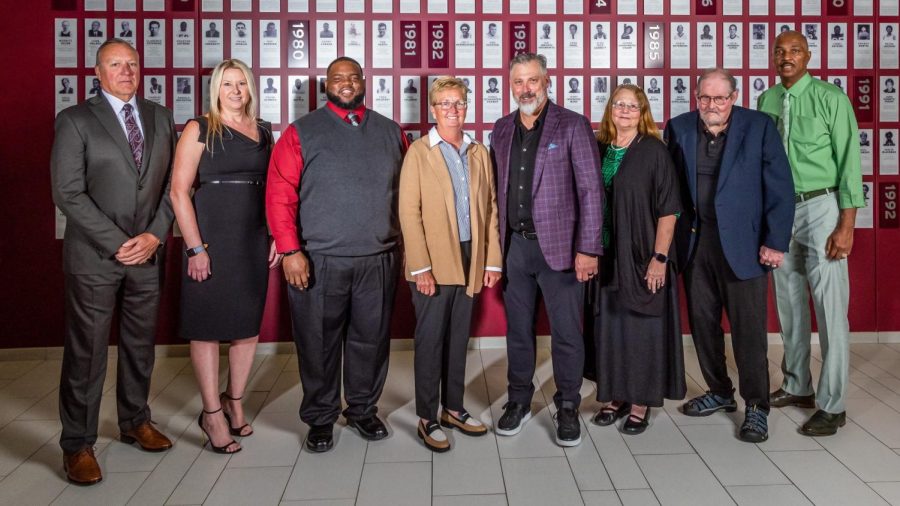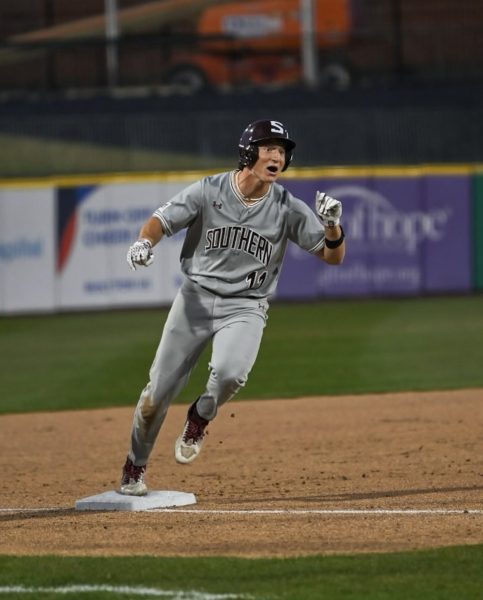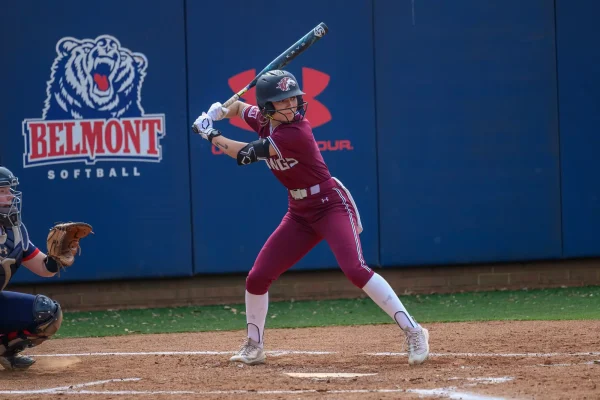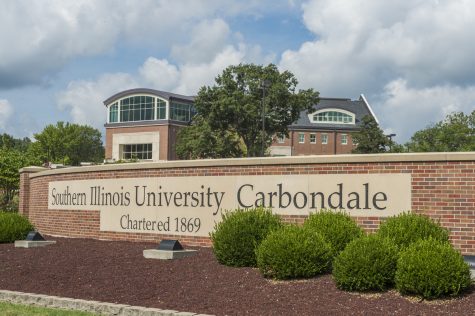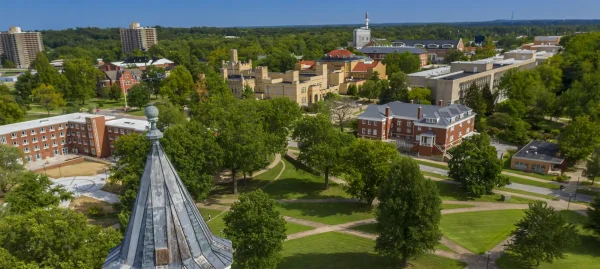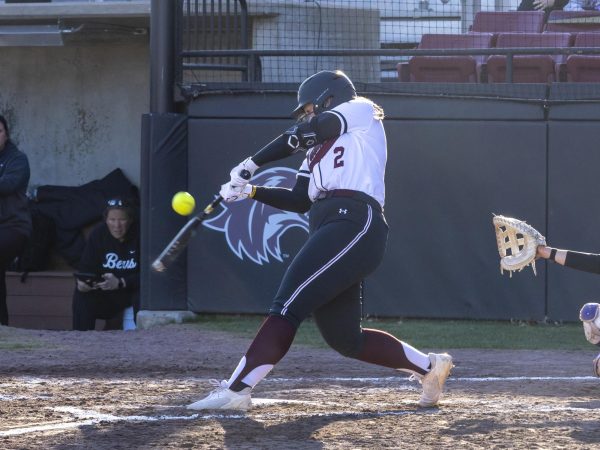SIU Hall of Fame inducts eight members in 2022 class
Saluki athletics officially inducted the eight-person 2022 class into its Hall of Fame in a ceremony on Friday night. The careers of the inductees spanned from as early as the 1960s to as recent as this year. Some of them are long-retired, while others are still pursuing careers both in and out of the sports world.
Among those inducted were athletes Corky Abrams, Elmer McDaniel, Bob Roop, Derek Shelton, and Carisa Winters; coaches Kerri Blaylock and Don DeNoon; and athletic trainer Ed Thompson.
“That guy was a lousy shot. Who could miss me?”
Advertisement
Professional wrestling has seen its fair share of colorful characters, and with them came colorful stories. It seems like practically everyone who steps into the squared circle has some crazy tale to tell, to the point where, when Bob Roop gave his Hall of Fame speech, he challenged himself to tell a story nobody in the room had heard before.
“Even if you had some great, outlandish story; you met a Martian or something, and you got a picture. The guy getting the next award will have met two Martians,” Roop said.
If the title of Roop’s 2021 book, “Wrestling For Saddam: Torture-Murder Attack of US Olympian as Accused Israeli Spy,” doesn’t catch someone’s eye, it’s hard to imagine what would.
In 1972, Roop wrestled in Baghdad, Iraq, before 200,000 spectators, including Saddam Hussein. At the time, Hussein used professional wrestling as a means to strengthen his political influence; treating the Iraqi champion Adnan Al-Kaissie, better known in the United States as General Adnan, as a symbol of his party’s perceived strength.
Roop won the match, and although the result was predetermined, it still infuriated Hussein. Roop was held hostage and tortured. He would end up being snuck out of the country, and would remain silent on the incident for nearly a half-century before releasing his book on it.
The year prior, wrestling legend Andre the Giant had worked that same match in Iraq in a losing effort. Roop told of a time when Andre was promoting a match in a nearby city, emphasizing how dangerous it was to be working in that area at the time.
“Somebody took a shot at him, and the bullet went through his hair,” Roop said.
Advertisement*
Andre was billed at 7-foot-4, and stood out practically anywhere he went due to his size. Years later, Roop asked Andre about his reaction to the assassination attempt.
“He said, ‘I thought that guy was a lousy shot. Who could miss me?’” Roop said, imitating Andre’s French accent.
During his three-year stint in the Army, Roop had a chance encounter with Larry Kristoff. Kristoff is a Carbondale-native who competed in the 1964 and 1968 Summer Olympic Games as a wrestler. In the lead-up to the ‘64 Games, he and Roop wrestled in a match.
“He beat me, but it was close,” Roop said. The effort seemed to be enough to impress Kristoff, who offered Roop a scholarship to come to Southern Illinois University.
Roop would go on to achieve a record of 66-18 as a Saluki, winning a national championship in his senior year. He made the U.S. Olympic team in 1968, and placed seventh in the Greco-Roman heavyweight division, losing to the eventual gold medal winner that year.
In accepting his induction, Roop voiced his respect for Kristoff, who was a 19-time national champion at SIU. He also emphasized how grateful he was for the opportunity he was given by Kristoff to become a Saluki.
“If you had a team of the last 50 years, and you had two people on it in each weight class of the best wrestlers this country produced, Larry would be on that team,” Roop said.
“In my mind, I’m wondering ‘what have I gotten into?’”
Corky Abrams received over 200 offers to play basketball in college, but it didn’t take long for him to choose Southern Illinois University. Just after beginning his first semester of classes, Abrams was pulled into the office of then-head coach Paul Lambert.
“He sat me down, and he wanted to talk to me about the next four years and his expectations,” Abrams said.
Lambert told Abrams his goals; each one seemed less realistic than the last. The first goal was to have four consecutive winning seasons “with minimal losses.” The second was to make the NCAA Tournament, something the Salukis had never done. By this point in the conversation, it started to feel more like a wishlist than expectations.
“Third thing on his bucket list: he actually wanted to join a powerhouse basketball conference,” Abrams said. Lambert had added that he ultimately wanted to win a championship as well.
At the time, Southern Illinois was an independent school after the shortlived Midwestern Conference dissolved in 1972. To not only find a conference to join, but a “powerhouse basketball conference,” was a tall task.
“In my mind, I’m wondering ‘what have I gotten into?’” Abrams said. “Why would you wait until I get here?”
Abrams’s career unfolded almost exactly as Lambert expected. From 1973-77, the Salukis had four winning seasons. They made the National Invitation Tournament in 1974, joined the Missouri Valley Conference in 1975, and won the conference championship in Abrams’s senior season along with a trip to the Sweet 16 of the NCAA Tournament.
Individually, Abrams set the school record for career field goal percentage at .599, which still stands to this day. He also finished among the all-time leaders in points, rebounds and assists. He was named to the All-Conference team in SIU’s first season in the Valley.
To this day, the 1977 team remains the farthest the Salukis have gone into the Division I NCAA Tournament, matched by the 2002 and 2007 Sweet 16 bids. Not only is Abrams’s Hall of Fame induction a testament to his talent, but also Lambert’s ability to see through to his expectations no matter how lofty they may have seemed.
“Last thing I remember is hearing ‘400 feet’ and we still couldn’t see the ground.”
When your career spans more than three decades, you cross paths with a lot of people. Ed Thompson estimated the number of Hall of Famers he worked with to be 135 including players, coaches, administrators, and Mike Reis. As an athletic trainer at Southern from 1979-2012, Thompson remembers working with pretty much everybody who went into the Hall of Fame this year.
In fact, Thompson began his speech with an anecdote about Abrams’s teammate Mike Glenn, who would go on to play 10 seasons in the NBA for the Buffalo Braves, New York Knicks, Atlanta Hawks and Milwaukee Bucks.
“Mike [Glenn] would come in, and assume that I wasn’t doing anything, and ask me to come out and rebound for him,” Thompson said.
With Glenn’s shooting prowess, Thompson said he would count 30 shots before Glenn would miss. It wouldn’t be a very difficult job to chase down the ball when it went through the hoop so consistently. This gave Thompson an idea when it came to Abrams.
“Corky [Abrams] was a tenacious rebounder, but if Corky would have come to the training room and asked me to come out and shoot for him, he would have had more rebounding practice than he could have ever known,” Thompson joked.
Thompson, a native of nearby Marion, had the opportunity to work with who he considers to be “the best trainer ever,” living only 16 miles away from campus. That trainer was Robert “Doc” Spackman, who was joined by Thompson as the only trainers in the Saluki Hall of Fame.
“I soon learned that there really wasn’t a more respected individual in the campus community, or really in southern Illinois, than Doc Spackman,” Thompson said.
Thompson also worked alongside Ed Dirks, who he described as having “never had a bad day.” An example of a program they worked on together was spending about 12 minutes a day with each pitcher in the baseball program working to improve their skill. One of those pitchers turned out to be Dave Stieb, who would become the best pitcher in MLB in the 1980s for the Toronto Blue Jays.
In the fall of 1979, Thompson had been given the opportunity in SIU athletics when then-AD Gale Sayers had a dispute with Spackman over his refusal to travel with the men’s basketball team, leading Spackman to resign. While Thompson and then-assistant trainer Harry Schulz were preparing for a football practice, Sayers walked down to the field.
“The athletic director comes walking in one gate…” Thompson said. “He looks at Harry and says ‘you’re the head trainer, and you’re [Thompson] the assistant,’ and walked out the other gate back to the office.”
And thus, a 33-year SIU Hall of Fame career in began, thanks to a Pro Football Hall of Famer in Sayers.
“I thought, ‘well that was a rigorous interview. I’m glad I passed,’” Thompson joked.
Thompson’s team consisted mostly of women’s head trainer Sally Perkins, and physician Rollin Perkins. He credits working for a quarter-century within the institution for giving them “the consistency in the equity of care that we maintained the whole time.”
It was also a guiding principle to ensure that athletes received equal treatment regardless of the sport they played. This reflected Spackman’s position against preferential treatment for men’s basketball when he clashed with Sayers in 1979.
“In order for our student athletes to trust in what we were recommending them to do, they had to believe that we had their best interest at heart,” Thompson said. “Same thing with our coaches.”
Across his career, Thompson worked with some of the biggest names in Saluki athletics history, including but not limited to Rey Dempsey, Bruce Weber, Matt Painter and Richard “Itchy” Jones.
Thompson shared a story about a flight he and Jones shared to St. Louis and back, which was marred by fog. At the time, Jones was learning to be a pilot and had a student-teacher with him, while Thompson stayed in the back of the plane.
“The last thing I remember is hearing ‘400 feet’ and we still couldn’t see the ground,” Thompson said. The 83-year old Jones, who was in attendance at the ceremony, confirmed the story.
Thompson accepted his induction on behalf of the trio of himself, Sally Perkins and Rollin Perkins. While he is only the second trainer to be inducted into the Hall of Fame, he believes he is far from the only one deserving of such an honor.
“Until they get more significant recognition directed at them, we’ll leave it at that,” Thompson said.
“He never made them do it alone.”
Don DeNoon became the first women’s track and field coach to be inducted into the SIU Hall of Fame. In an 18-year career between 1983-2001, DeNoon was a three-time conference Coach of the Year, six-time conference outdoor champion, and three-time indoor champion. He produced three All-Americans and three Olympians, including Connie Price-Smith.
To his daughter Patricia, he is simply her dad.
“I remember my dad as someone who was always there for me,” Patricia DeNoon said. “No matter how busy he was, and coaching is definitely a six-to-seven day a week job, I never felt like he wasn’t there.”
Don DeNoon ran track and field in high school, being recruited to the team after a friend told the coach how fast he was.
“He would race home after school to complete his paper route so that he could make it back to baseball practice,” Patricia DeNoon said.
A known race walker, Don DeNoon is said to have earned respect with his six-minute mile time while walking. He kept up his athletic ability during his time as a coach, and never felt detached from the athletes he was responsible for.
“He never made them do it alone,” Patricia DeNoon said. “Often, my dad would run with his athletes in practices, showing them that not only was he their coach, but that he could still keep up with them, and was willing to work as hard as what he asked them for.”
Upon Don DeNoon’s death in March 2021, many Salukis expressed their love and support for their former coach. With his posthumous induction, Patricia said that he was not one to chase that recognition.
“He would be honored to receive this award tonight. But, he wouldn’t want all the fanfare that goes along with it… He never intentionally stepped into the spotlight, but the light has shone on him many times.”
“I love Itch like a father; do not get in a car with him.”
When Derek Shelton was in kindergarten, his teacher asked everyone what they wanted to be when they grew up. Only two students did exactly what they said they would; one became a dentist, and the other became a Saluki.
Now, at age 52, Shelton is a Saluki Hall of Famer, and has been the manager of the Pittsburgh Pirates of Major League Baseball since 2020. If you asked him which accomplishment he was most proud of, the Carbondale-native would point to the former.
“Today was the first day my wife and my youngest have ever been on campus here,” Shelton said. “And to be able to walk around and to see everything, to share that with them was really special.”
Shelton is the son of two SIU graduates. He attended a baseball camp at Southern Illinois when he was eight years old, riding the train to campus and meeting Saluki baseball coach “Itchy” Jones. His relationship with Jones spanned the next few decades, all the way up until Shelton played catcher for his Saluki team in 1990.
“I caught the last game that he [Jones] coached here,” Shelton said. “That kinda hit me a little bit, because we’re talking about a living legend at this institution. That resonated a lot with me because of how much he’s meant to me throughout the years.”
His experience around Jones left him surprised when he heard Ed Thompson’s story where he got in a plane with the legendary coach. Shelton took it one step further, recommending avoiding any transportation with Jones.
“On my recruiting visit here, we drove through the University Mall, and it’s quite possibly the scariest moment of my life,” Shelton said. “I love Itch like a father.; do not get in a car with him.”
While Shelton’s Pittsburgh Pirates haven’t had the most success on the field, as they’ve had a 100-loss pace in each of his first three seasons, just reaching the point he is at is success in itself. Shelton is the first Saluki to ever become a head coach or manager of a major pro sports team.
“I’m trying to spend as much time as possible around Kerri [Blaylock] and Itch [Jones] because they’ve got a lot of wins, and we need wins,” Shelton joked.
In a Saluki uniform, Shelton was considered a high-end defensive catcher. He played 177 games from 1989-92, and played on Southern’s most recent NCAA Tournament team in 1990, which was also Jones’s final year before leaving for the University of Illinois.
The Salukis have been pushing to break back into the postseason recently under head coach Lance Rhodes. They won 40 games in back-to-back years, and seem to be on the cusp of repeating the feat that Shelton’s 1990 team accomplished.
“I told Lance’s [Rhodes] group today. This group, next year, this is the group that breaks that,” Shelton said.
After Shelton’s minor league baseball career didn’t pan out, Saluki baseball coach Dan Callahan, who would go on to be the second-winningest coach behind Jones, offered him a position as a volunteer assistant. That job planted the seeds for Shelton’s return to baseball and a second career as a coach.
Also on that mid-1990s Saluki staff was Derek Johnson, who served as a graduate assistant. Johnson is currently the pitching coach for the Cincinnati Reds, who are a division rival to the Pirates.
Shelton’s final big break came when Mark Newman, another SIU Hall of Famer, offered him a coaching job in the New York Yankees minor league system. Newman was one of the people responsible for the Yankees dynasty of the late-90s, but to Shelton, he was a former Saluki helping a fellow Saluki.
“I think a large part of that was because of the trust he had for the fact of where I had been and who I had been around,” Shelton said.
“A lot of coaches would have gotten fed up…”
Carisa Winters’s path to the Salukis was paved by several people close to her. Perhaps none closer than her family; her father helped drive her to practice and school when he wasn’t working the second shift, and her mother helped her pursue softball at a young age by being her catcher when she practiced.
“She squatted down and caught softballs until I was in fifth grade and I was too fast,” Winters said.
More people she credited for her success were former coaches: Stephanie Walker, who Winters described as a “this crazy pitching coach that lived in Murphysboro,” and taught her how to pitch; legendary Herrin softball coach Bruce Jilek and Saluki Hall of Fame coach Kay Brechtelsbauer. Walker and Jilek both passed away in 2021, and Brechtelsbauer died a month before Winters’s induction.
Winters transferred to Herrin for her junior year of high school to play for Jilek. She would wake up early in the morning to get a pitching session in before school, which she chose the 5:30 a.m. time slot for.
“Jilek’s pitching techniques have been replicated through all levels of softball, and I dare go as far, country-wide,” Winters said.
Winters met Brechtelsbauer and assistant coach Kerri Blaylock when she was being recruited to become a Saluki. They gave her the opportunity to achieve her dream she had worked toward her entire life: getting a scholarship at a Division I school.
She also credited Brechtelsbauer for having “a lot of compassion, and a lot of patience,” as Winters matured as a young adult. From meeting her at age 16, to seeing her through to graduation at SIU, Brechtelsbauer kept her steady through both her athletic career and her academic career.
“A lot of coaches would have gotten fed up, and they would have tossed me on and moved on,” Winters said. “Not Coach B [Brechtelsbauer].”
Once she was on the field, Winters was lights-out. In a 26-day span in spring 1997, she threw four no-hitters for a program that has only seen 33 across its entire history. She would go on to make the All-MVC team in each of the next three seasons, and would have a win or save in 64 of the team’s 111 wins in those years.
Winters credited her teammates, especially those on defense, for much of her success as a pitcher.
“Lori Greiner diving to catch a ball to get an out. Karrie Fortman playing when she broke her thumb and it was blue for like a month-and-a-half, catching every pitch. Jamie Campbell turning a double play. The list goes on and on,” Winters said.
Winters played her last year for Southern Illinois in 2000. That senior season coincided with Blaylock’s first year as the head coach of the softball team, and the beginning of a new era for the program.
“We’re beating Stanford!”
Most of the time, just the Hall of Fame accolade would be enough to encapsulate someone’s career. But some are so instrumental in their contributions to a program that it is impossible to do them justice.
Blaylock took over for Brechtelsbauer to become just the second-ever Saluki softball coach in 2000. She led the program for 22 seasons, eventually passing Itchy Jones for the most wins in any sport in school history with a 751-413-1 career record.
“I tell Itchy often that if he hadn’t left and gone to the University of Illinois, I would not have broken his record,” Blaylock said.
Saluki softball burst onto the national scene under Blaylock, making eight NCAA Tournament appearances and becoming the only program in MVC history to reach five straight postseasons. Like many Hall of Famers before her, behind Blaylock’s success were all of her supporters.
“I had the original girl dad,” she said. “He was my person, my best friend. I was always included in every game of catch, every fishing trip, every hunting trip.”
The Herrin-native holds many records at the University of Evansville as a pitcher. Her Saluki career began when she was given the opportunity by Brechtelsbauer to be an assistant coach for Southern Illinois in 1991. Brechtelsbauer would retire with 633 wins in 32 seasons as the winningest coach in SIU women’s athletics.
“She laid an unbelievable foundation for me to build on,” Blaylock said.
Finally, she recognized Bruce Jilek, who had taught her how to pitch. Jilek’s impact spanned multiple generations, as he mentored Blaylock and later Winters, who would go on to share a dugout in 2000.
“Jilek’s the reason I wanted to be a coach,” Blaylock said. “I wanted to be just like him.”
As the head coach of a mid-major program, Blaylock faced an uphill battle when it came to building a competitive team. Against powerhouses like Alabama and Stanford, she needed to be a hard-working recruiter to keep up with them.
“Coaches at our level outwork others if we want to succeed at the national level,” Blaylock said. “We don’t complain about hours or pay. We just get after it.”
During her tenure, Saluki softball won 20 games against ranked opponents. In 2007, SIU peaked at No. 18 in the national rankings; it tied that mark again in 2009.
“You don’t know how proud it is when you’re beating those teams with all that money, and you’re representing this area,” Blaylock said.
Blaylock reflected on a game in the 2003 NCAA Tournament, where the Salukis were leading 6-0 in the fourth inning against Stanford, who was the middle of 16-straight tournament appearances.
“I looked at [assistant coach] Buddy [Foster] and said ‘we’re beating Stanford!’” Blaylock said. “He said ‘shut up.’”
The underdog story of a Herrin-native taking a mid-major program into the national spotlight is one that might seem too good to be true. But under Blaylock, it did come true. She retired in 2022, giving way to new head coach Jen Sewell. Considering the track record of her predecessors, Sewell has a lot to live up to, but Blaylock is confident that she will continue the legacies that both Coach B’s left.
“I’m not a man of many words.”
Elmer McDaniel didn’t have much to say when he was inducted. While the average Hall of Fame speech would last between 10-20 minutes, McDaniel stood on the stage for around five minutes.
His Saluki career didn’t last very long either, only spending two years with the football team. The fact that he built a Hall of Fame career within 24 months shows how much he meant to those teams of the early-2000s.
A consensus All-American center, McDaniel anchored the offensive line for a team that went 20-4 with two conference championships and two playoff appearances. He noted that seven of his teammates are also in the Hall of Fame, including six that he blocked for.
McDaniel received what he described as a “Christmas present” on Christmas Eve 2002, when head coach Jerry Kill offered him a scholarship to join the Salukis out of junior college.
“It only took me two days,” McDaniel said of his decision. “I told Coach Kill, that’s where my heart is. That’s where I need to be.”
Seemingly as quickly as he burst onto the scene and contributed to a playoff team, McDaniel graduated. It felt poetic that his Hall of Fame speech was as brief as it was.
McDaniel proved that someone didn’t need to be a coach for 20 years to have an impact on a program. Some of his teammates made it to the NFL; McDaniel didn’t. But in his short time at SIU, he played his way onto the same wall as those teammates, and many others immortalized into the Saluki Hall of Fame.
Staff reporter Brandyn Wilcoxen can be reached at bwilcoxen@dailyegyptian.com or on Twitter at @BrandynWilcoxen. To stay up to date with all your southern Illinois news, follow the Daily Egyptian on Facebook and Twitter.
Advertisement



